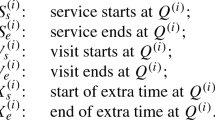Abstract
In this paper, we consider polling systems with J stations with Poisson arrivals and general service distributions attended by a cyclic server. The service discipline at each station is either exhaustive or gated. We propose a new approach to analysis of the mean waiting times in the polling systems. The outline of our method is as follows. We first define the stochastic process Q that represents an evolution of the system state, and define three types of the performance measures W i ,H i and F i , which are the expected waiting times conditioned on the system state. Then from the analysis of customers at polling instants, we find their linear functional expressions. The steady state average waiting times can be derived from the performance measures by simple limiting procedures. Their actual values can be obtained by solving J(J+1) linear equations.
Similar content being viewed by others
References
J.E. Baker and I. Rubin, Polling with a general-service order table, IEEE Trans. Commun. 35 (1987) 283-288.
O.J. Boxma, Workloads and waiting times in single-server systems with multiple customer classes, Queueing Systems 5 (1989) 185-214.
O.J. Boxma and W.P. Groenendijk, Pseudo-conservation laws in cyclic-service systems, J. Appl. Probab. 24 (1987) 949-964.
R.B. Cooper, Queues served in cyclic order: Waiting times, Bell System Tech. J. 49 (1970) 399-413.
R.B. Cooper and G. Murray, Queues served in cyclic order, Bell System Tech. J. 48 (1969) 675-689.
M. Eisenberg, Queues with periodic service and changeover time, Oper. Res. 20 (1972) 440-451.
M.J. Ferguson and Y.J. Aminetzah, Exact results for nonsymmetric token ring systems, IEEE Trans. Commun. 33 (1985) 223-231.
T. Hirayama, Analysis of multiclass M/G/1 queues with a mixture of 1-limited disciplines and gated disciplines, J. Oper. Res. Soc. Japan 42 (1999) 237-255.
T. Hirayama, A multiclass polling system with feedback, in: Proc. of the IASTED Internat. Conf. on Networks, Parallel and Distributed Processing, and Applications, eds. J. Li, K. Kato and H. Kameda (ACTA Press, Anaheim,2002) pp. 154-159.
T. Hirayama, Mean sojourn times in multiclass feedback queues with gated disciplines, Naval Research Logistics 50 (2003) 719-741.
S.J. Hong and T. Hirayama, A new approach to analyze polling systems, in: Proc. of the Sympos. on Performance Models for Information Communication Networks, ed. O. Hashida (1995) pp. 13-24.
L. Kleinrock and H. Levy, The analysis of random polling systems, Oper. Res. 36 (1988) 716-732.
A.G. Konheim, H. Levy and M.M. Srinivasan, Descendant set: An efficient approach for the analysis of polling systems, IEEE Trans. Commun. 42 (1994) 1245-1253.
A.G. Konheim and B. Meister, Waiting lines and times in a system with polling, J. Assoc. Comput. Mach. 21 (1974) 470-490.
H. Levy, Delay computation and dynamic behavior of non-symmetric polling systems, Performance Evaluation 10 (1989) 35-51.
H. Levy, Binomial-gated service: A method for effective operation and optimization of polling systems, IEEE Trans. Commun. 39 (1991) 1341-1350.
H. Levy and M. Sidi, Polling systems: Applications, modeling, and optimization, IEEE Trans. Commun. 38 (1990) 1750-1760.
D. Sarkar and W.I. Zongwill, Expected waiting time for nonsymmetric cyclic queueing systems - Exact results and applications, Managm. Sci. 35 (1989) 1463-1474.
M. Sidi, H. Levy and S.W. Fuhrmann, A queueing network with a single cyclically roving server, Queueing Systems 11 (1992) 121-144.
M.M. Srinivasan, Nondeterministic polling systems, Managm. Sci. 37 (1991) 667-681.
M.M. Srinivasan, H. Levy and A.G. Konheim, The individual station technique for the analysis of cyclic polling systems, Naval Research Logistics 43 (1996) 79-101.
G.B. Swartz, Polling in a loop system, J. Assoc. Comput. Mach. 27 (1980) 42-59.
H. Takagi, Analysis of polling systems with a mixture of exhaustive and gated service disciplines, J. Oper. Res. Soc. Japan 32 (1989) 450-461.
[24]H. Takagi, Queueing analysis of polling models: Progress in 1990-1994, in: Frontiers in Queueing: Models and Applications in Science and Engineering, ed. J.H. Dshalalow (CRC Press, Boca Raton, FL, 1997) pp. 119-146.
H. Takagi, Analysis and application of polling models, in: Performance Evaluation: Origins and Directions, eds. G. Haring, C. Lindemann and M. Reiser, Lecture Notes in Computer Science, Vol. 1769 (Springer, Berlin, 2000) pp. 423-442.
W. Whitt, A review of L= ?Wand extensions, Queueing Systems 9 (1991) 235-268.
R.W. Wolff, Poisson arrivals see time averages, Oper. Res. 30 (1982) 223-231.
R.W. Wolff, Stochastic Modeling and the Theory of Queues(Prentice-Hall, Englewood Cliffs, NJ, 1989).
Author information
Authors and Affiliations
Rights and permissions
About this article
Cite this article
Hirayama, T., Hong, S.J. & Krunz, M.M. A New Approach to Analysis of Polling Systems. Queueing Systems 48, 135–158 (2004). https://doi.org/10.1023/B:QUES.0000039891.78286.dd
Issue Date:
DOI: https://doi.org/10.1023/B:QUES.0000039891.78286.dd




